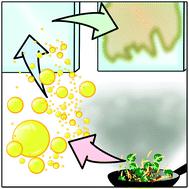当前位置:
X-MOL 学术
›
Environ. Sci.: Processes Impacts
›
论文详情
Our official English website, www.x-mol.net, welcomes your
feedback! (Note: you will need to create a separate account there.)
Glass surface evolution following gas adsorption and particle deposition from indoor cooking events as probed by microspectroscopic analysis.
Environmental Science: Processes & Impacts ( IF 4.3 ) Pub Date : 2020-06-23 , DOI: 10.1039/d0em00156b Victor W Or 1 , Michael Wade 2 , Sameer Patel 3 , Michael R Alves 1 , Deborah Kim 1 , Sarah Schwab 1 , Hannah Przelomski 4 , Rachel O'Brien 4 , Donghyun Rim 5 , Richard L Corsi 6 , Marina E Vance 3 , Delphine K Farmer 7 , Vicki H Grassian 8
Environmental Science: Processes & Impacts ( IF 4.3 ) Pub Date : 2020-06-23 , DOI: 10.1039/d0em00156b Victor W Or 1 , Michael Wade 2 , Sameer Patel 3 , Michael R Alves 1 , Deborah Kim 1 , Sarah Schwab 1 , Hannah Przelomski 4 , Rachel O'Brien 4 , Donghyun Rim 5 , Richard L Corsi 6 , Marina E Vance 3 , Delphine K Farmer 7 , Vicki H Grassian 8
Affiliation

|
Indoor surfaces are extremely diverse and their interactions with airborne compounds and aerosols influence the lifetime and reactivity of indoor emissions. Direct measurements of the physical and chemical state of these surfaces provide insights into the underlying physical and chemical processes involving surface adsorption, surface partitioning and particle deposition. Window glass, a ubiquitous indoor surface, was placed vertically during indoor activities throughout the House Observations of Microbial and Environmental Chemistry (HOMEChem) campaign and then analyzed to measure changes in surface morphology and surface composition. Atomic force microscopy-infrared (AFM-IR) spectroscopic analyses reveal that deposition of submicron particles from cooking events is a contributor to modifying the chemical and physical state of glass surfaces. These results demonstrate that the deposition of glass surfaces can be an important sink for organic rich particles material indoors. These findings also show that particle deposition contributes enough organic matter from a single day of exposure equivalent to a uniform film up to two nanometers in thickness, and that the chemical distinctness of different indoor activities is reflective of the chemical and morphological changes seen in these indoor surfaces. Comparison of the experimental results to physical deposition models shows variable agreement, suggesting that processes not captured in physical deposition models may play a role in the sticking of particles on indoor surfaces.
中文翻译:

显微吸收分析表明,室内烹饪过程中气体吸附和颗粒沉积后玻璃表面的演变。
室内表面极为多样,它们与空气传播的化合物和气溶胶的相互作用会影响室内排放物的寿命和反应性。通过直接测量这些表面的物理和化学状态,可以洞悉涉及表面吸附,表面分配和颗粒沉积的潜在物理和化学过程。在整个“房屋微生物与环境化学观察”(HOMEChem)活动期间的室内活动期间,将玻璃窗(一种无处不在的室内表面)垂直放置在室内,然后进行分析以测量表面形态和表面组成的变化。原子力红外光谱仪(AFM-IR)的光谱分析表明,烹饪过程中亚微米颗粒的沉积是改变玻璃表面化学和物理状态的原因。这些结果表明,玻璃表面的沉积可能是室内富含有机物的颗粒材料的重要沉陷。这些发现还表明,粒子的沉积从一天的暴露中就足以贡献足够的有机物,相当于厚度均匀至两纳米的均匀薄膜,并且不同室内活动的化学区别反映了这些室内所见的化学和形态变化表面。实验结果与物理沉积模型的比较显示出可变的一致性,这表明物理沉积模型中未捕获的过程可能在室内表面颗粒粘附中起作用。这些发现还表明,颗粒物的沉积从一天的暴露中就足以贡献足够的有机物,相当于厚度达到两纳米的均匀薄膜,并且不同室内活动的化学区别反映了这些室内所见的化学和形态变化表面。实验结果与物理沉积模型的比较显示出可变的一致性,这表明物理沉积模型中未捕获的过程可能在室内表面颗粒粘附中起作用。这些发现还表明,粒子的沉积从一天的暴露中就足以贡献足够的有机物,相当于厚度均匀至两纳米的均匀薄膜,并且不同室内活动的化学区别反映了这些室内所见的化学和形态变化表面。实验结果与物理沉积模型的比较显示出可变的一致性,这表明物理沉积模型中未捕获的过程可能在室内表面的颗粒粘附中起作用。
更新日期:2020-08-19
中文翻译:

显微吸收分析表明,室内烹饪过程中气体吸附和颗粒沉积后玻璃表面的演变。
室内表面极为多样,它们与空气传播的化合物和气溶胶的相互作用会影响室内排放物的寿命和反应性。通过直接测量这些表面的物理和化学状态,可以洞悉涉及表面吸附,表面分配和颗粒沉积的潜在物理和化学过程。在整个“房屋微生物与环境化学观察”(HOMEChem)活动期间的室内活动期间,将玻璃窗(一种无处不在的室内表面)垂直放置在室内,然后进行分析以测量表面形态和表面组成的变化。原子力红外光谱仪(AFM-IR)的光谱分析表明,烹饪过程中亚微米颗粒的沉积是改变玻璃表面化学和物理状态的原因。这些结果表明,玻璃表面的沉积可能是室内富含有机物的颗粒材料的重要沉陷。这些发现还表明,粒子的沉积从一天的暴露中就足以贡献足够的有机物,相当于厚度均匀至两纳米的均匀薄膜,并且不同室内活动的化学区别反映了这些室内所见的化学和形态变化表面。实验结果与物理沉积模型的比较显示出可变的一致性,这表明物理沉积模型中未捕获的过程可能在室内表面颗粒粘附中起作用。这些发现还表明,颗粒物的沉积从一天的暴露中就足以贡献足够的有机物,相当于厚度达到两纳米的均匀薄膜,并且不同室内活动的化学区别反映了这些室内所见的化学和形态变化表面。实验结果与物理沉积模型的比较显示出可变的一致性,这表明物理沉积模型中未捕获的过程可能在室内表面颗粒粘附中起作用。这些发现还表明,粒子的沉积从一天的暴露中就足以贡献足够的有机物,相当于厚度均匀至两纳米的均匀薄膜,并且不同室内活动的化学区别反映了这些室内所见的化学和形态变化表面。实验结果与物理沉积模型的比较显示出可变的一致性,这表明物理沉积模型中未捕获的过程可能在室内表面的颗粒粘附中起作用。











































 京公网安备 11010802027423号
京公网安备 11010802027423号